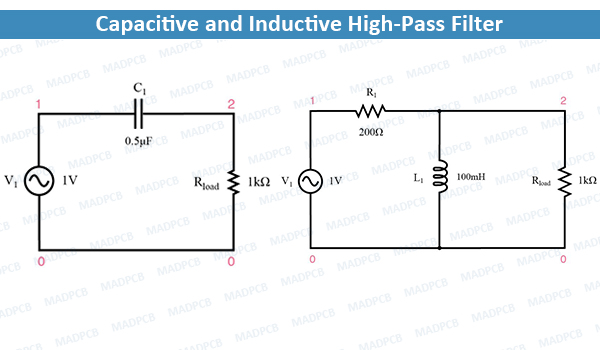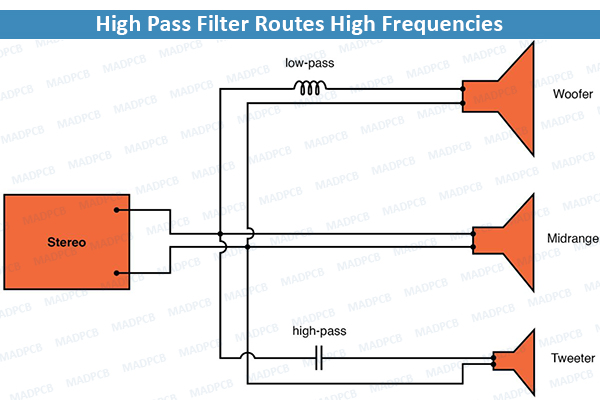What’s a High-pass Filter?
A High-pass Filter (HPF) is an electronic filter that passes signals with a frequency higher than a certain cutoff frequency and attenuates signals with frequencies lower than the cutoff frequency. The amount of attenuation for each frequency depends on the filter design. A high-pass filter is usually modeled as a linear time-invariant system. It is sometimes called a Low-cut Filter or Bass-cut Filter in the context of audio engineering.
As one might expect, the inductive and capacitive versions of the High-pass Filter are just the opposite of their respective low-pass filter designs:

Capacitive and Inductive High-Pass Filter
The Capacitor’s Impedance
The capacitor’s impedance increases with decreasing frequency. (Figure below) This high impedance in series tends to block low-frequency signals from getting to load.
The Inductor’s Impedance
The inductor’s impedance decreases with decreasing frequency. (Figure below) This low impedance in parallel tends to short out low-frequency signals from getting to the load resistor. As a consequence, most of the voltage gets dropped across series resistor R1.
This time, the capacitive design is the simplest, requiring only one component above and beyond the load. And, again, the reactive purity of capacitors over inductors tends to favor their use in filter design, especially with high-pass filters where high frequencies commonly cause inductors to behave strangely due to the skin effect and electromagnetic core losses.
Cutoff Frequency
As with low-pass filters, high-pass filters have a rated cutoff frequency, above which the output voltage increases above 70.7% of the input voltage. Just as in the case of the capacitive low-pass filter circuit, the capacitive high-pass filter’s cutoff frequency can be found with the same formula:
fcutoff = 1/2πRC
In the example circuit, there is no resistance other than the load resistor, so that is the value for R in the formula.
Application of High-Pass Filter
Using a stereo system as a practical example, a capacitor connected in series with the tweeter (treble) speaker will serve as a high-pass filter, imposing a high impedance to low-frequency bass signals, thereby preventing that power from being wasted on a speaker inefficient for reproducing such sounds.
In like fashion, an inductor connected in series with the woofer (bass) speaker will serve as a low-pass filter for the low frequencies that particular speaker is designed to reproduce.
In this simple example circuit, the midrange speaker is subjected to the full spectrum of frequencies from the stereo’s output. More elaborate filter networks are sometimes used, but this should give you the general idea.
Also bear in mind that I’m only showing you one channel (either left or right) on this stereo system. A real stereo would have six speakers: 2 woofers, 2 midranges, and 2 tweeters.

High Pass Filter Routes High Frequencies
For better performance yet, we might like to have some kind of filter circuit capable of passing frequencies that are between low (bass) and high (treble) to the midrange speaker so that none of the low- or high-frequency signal power is wasted on a speaker incapable of efficiently reproducing those sounds.
What we would be looking for is called a band-pass filter, which is the topic of the next section.
Review
- A high-pass filter allows for easy passage of high-frequency signals from source to load, and difficult passage of low-frequency signals.
- Capacitive high-pass filters insert a capacitor in series with the load; inductive high-pass filters insert a resistor in series and an inductor in parallel with the load. The former filter design tries to “block” the unwanted frequency signal while the latter tries to short it out.
- The cutoff frequency for a high-pass filter is that frequency at which the output (load) voltage equals 70.7% of the input (source) voltage. Above the cutoff frequency, the output voltage is greater than 70.7% of the input, and vice versa.
